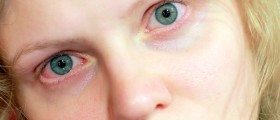
Eye infections can result when a potentially harmful pathogen or irritant that can be damaging to the eye enters. Eye infections can affect all parts of the eye, including the eyelid, eyeball, and cornea.
Most often, an eye infection is not a big threat and is simply irritating and uncomfortable.
However, the risks depend on the actual infection. Pink eye, for instance, is associated with pain and may cause severe damage to the affected structures.
It is vital that a person does not leave an eye infection untreated because this can lead to certain complications, including in extreme cases vision loss. The best thing is to consult an ophthalmologist when experiencing any eye problems. Apart from being examined and treated by an expert, one may also benefit from various kinds of home remedies and boric acid is only one of them.
Eye Infection and Boric Acid
Pink eye is otherwise known as conjunctivitis and it is considered to be one of the most frequently seen eye infections. A person who is suffering from conjunctivitis typically experiences inflammation of the membrane covering the eyelid and eyeball. That triggers dilation of blood vessels on the surface of the eye and this explains redness of the affected eye.
Pink eye does not come without symptoms like a burning sensation or the feeling of having sand in the eye. Dryness, itchiness and light sensitivity are also present almost all the time when a person is suffering from pink eye. Consulting a health care provider soon after symptoms occur is of great significance.
Apart from going to the eye doctor, there is a certain home remedy that many individual prefer to use in this situation. Making an eyewash out of boric acid is considered to be a potential remedy for pink eye, eye infections in general, and even in case chemicals or small objects irritate the eye. This is because boric acid acts as an antimicrobial agent.
In order for a boric acid eyewash to be made, a person simply needs to mix a cup of boiling water with 1 tablespoon of boric acid and ten drops of golden seal tincture. The mixture should not be used before it has cooled, to avoid exposing your eye to warm temperatures.
After applying the boric acid eyewash, the mixture should be left to dry in the eye and then rinsed with lukewarm water. A person can use an eye dropper, eye cup or a cotton swab in order to apply the mixture to the eye. Doctors advise that this should be done more than three times per day. Paying attention not to use the mixture on any other parts of the face is very important.
When making the mixture it is essential that the right amount of water and boric acid is mixed. Too much water will reduce the effectiveness of the remedy and too much boric acid will only make the symptoms worse.
What is Boric Acid?
Boric acid is also called acidum boricum and orthoboric acid. Numerous products which are classified as antiseptic and insecticidal contain boric acid. Two forms of boric acid exist and these are colorless crystals and white powder. Both of them are water soluble. Apart from pink eye, the mixture which has boric acid in it is also used for eye dryness, watering eyes, and eye burning and itching.
Preparing boric acid mixtures and applying them to your eyes should never be done without talking to your (eye) doctor first.
Two of the main reasons why boric acid is an excellent remedy for eye infections are its anti-fungal and anti-bacterial properties. Not only will boric acid get rid of pollutants like dust and chemicals from the eye but it will also ease the symptoms like itchiness and irritation.
Those people who are allergic to boric acid should definitely avoid using the solution. A person who is wearing contact lenses should remove them before applying the mixture.
How does Eye Infection Occur?
Eye infections can be caused by bacteria, viruses, and fungi. Although they cannot always be avoided, good hygiene, including properly storing contact lenses if you wear them, and disinfecting them regularly, can help prevent them. Sharing towels is another easy way to catch someone else's eye infection.
Regardless of the cause, catching an infection early can help minimize thr risk of complications. Symptoms of an eye infection will include eyes that are:
- Red
- Swollen
- Itchy
- Painful
- Dry, or on the other hand discharging or oozing
If you notice these symptoms, see a doctor as soon as possible.
Aspergillus endophthalmitis: One cause of eye infection
Soil, decaying vegetation and stored hay are the usual places where Aspergillus species grow. Exposure to these species occurs almost daily but the actual infection caused by Aspergillus does not happen that often. Such infection leads to keratitis and orbital cellulitis in the majority of patients.
Aspergillus endophthalmitis is not a common occurrence but it is actually a very dangerous infection as it precipitate visual loss. Another problem is that doctors have a lot of problems diagnosing this condition and the treatment is often unsuccessful. Other organs get infected with the species first and then the infection spreads to the eyes. Medical experts believe that leucopenia is the predisposing condition which leads to aspergillosis.
In some cases of Aspergillus endophthalmitis vitreous biopsy or culture can give negative results. This only makes the process of diagnosing rather challenging.
The situation where intraocular inflammation is secondary to Aspergillus happens more often in the central macula. When this occurs, the prognosis is not good. Amphotercin B is considered to be a potent antifungal agent for aspergillosis. However, if there is no host immune competence, the treatment usually ineffective. A certain study proved that every patient with immune deficiency should be thought of having Aspergillus endophthalmitis even if the systemic aspergillosis is not present or confirmed.

















Your thoughts on this
Loading...